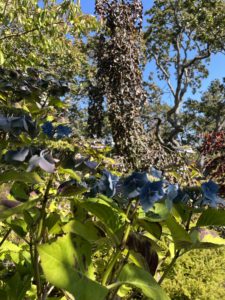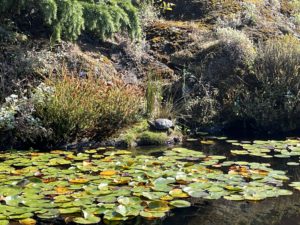Kathleen Bazkur takes us all along on her trip to Abkhazi Garden:
A dear friend once said, “travel is like an RRSP for the mind”. On this still wintry spring day, I think of my trip to British Columbia in the fall of 2023, to take advantage of that sentiment.
While I was fortunate to visit a number of gardens, including VanDusen Botanical Garden (https://vandusengarden.org/ ) and the Butchart Gardens (https://www.butchartgardens.com/), it was a visit to Abkhazi Garden (https://www.abkhaziteahouse.com/garden-tours) in Victoria, that captured my heart. It symbolizes a triumph of love over adversity.
The one-acre “garden that love built” began in 1946, when Peggy Pemberton-Carter and the exiled Georgian Prince, Nicolas Abkhazi settled in Victoria. Prince Nicolas fled Georgia during the Russian Revolution. They met, as friends, in Paris in the 1920s, but drifted apart. When World War II erupted, Prince Nicolas served in the French army and was captured. Peggy resided in Shanghai and also spent time in captivity. They reunited and married in New York in 1946. The garden became an outlet of their love and creativity, with experimentation and constant refinement a hallmark of their commitment to the land for over four decades.
The structural components of the garden, including the trees, buildings, statuary, pathways and seating fold sympathetically into their surroundings. The house, summerhouse and terrace do not upstage nature; they complement it. The use of natural wood and stone, along with design, ensure that the buildings work in collaboration with their setting. There is an abundance of seating for rest, enjoyment and reflection, but my favourite is the oriental-style bench, pictured below, in the Yangtze River section of the garden in which numerous paths tease new and breathtaking views.
Also part of the Yangzte River section are three ponds that serve as a home for resident turtles.
While heather and other plants were in bloom during my visit, it was the artful and elegant mix of foliage that impressed me most. Outstanding Japanese maples, rhododendrons and Garry oaks have flourished through the decades.
While wandering through the garden, I found this stone with the initials “LA” and the year 1949 carved in it.
Learn more about the Abkhazi Garden’s heritage here: https://www.abkhaziteahouse.com/the-legacy





